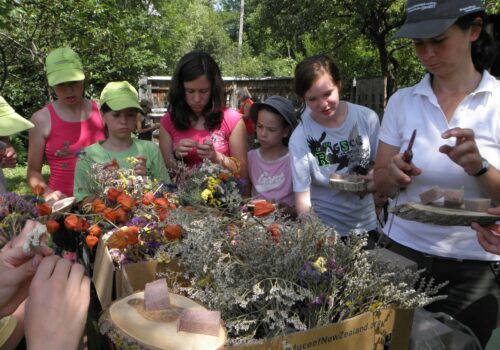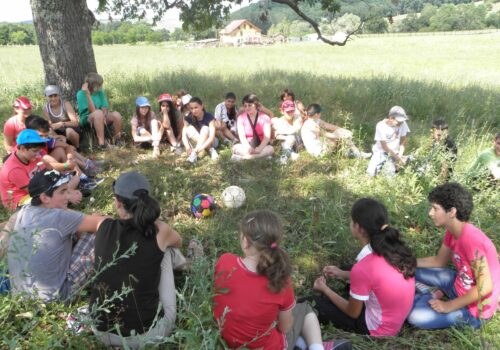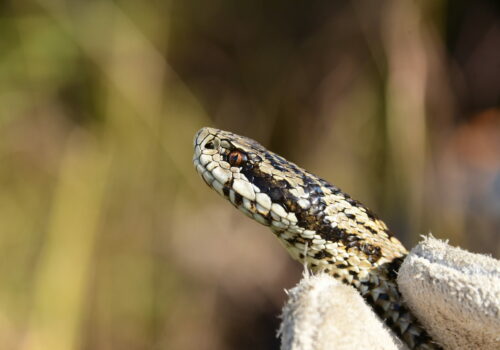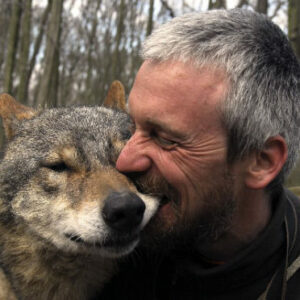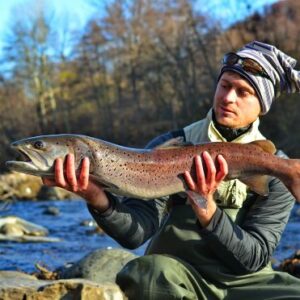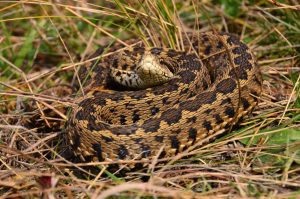
History has been hard on the Hungarian Meadow Viper (
Vipera ursinii rakosiensis). A subspecies of the grassland dwelling meadow viper (
Vipera ursinii), it has been persecuted under the false fear that it may be dangerous, caught and sold as pets and poisoned by agricultural chemicals. Most devastatingly though, this once widespread subspecies has had its habitats increasingly destroyed as changes in land use have seen it’s native grasslands being ploughed for use as arable land, overgrazed and burned, forcing the viper into ever smaller pockets of protected land.
Now, it is one of the most threatened snake subspecies in Europe and, even with conservation policies being carried out to save it, the population is in decline. In Romania, there are four known habitat sites, three of which have been recently discovered or reconfirmed by scientists.. All the sites can be found in the steppe grasslands from hills of Cluj and Alba County and three are located within Natura 2000 protected areas while the fourth is in a proposed Natura 2000 site. The largest of these is Pajiștile lui Suciu, located in Alba County, and contains an estimated 300-400 Hungarian Meadow Vipers in an area of 200 ha (though the viper appears to live predominantly within just 30 ha of this space). The smallest is Pajiștile de la Rădești, also in Alba County, an area of 35 ha in size where just 2 vipers have been encountered.
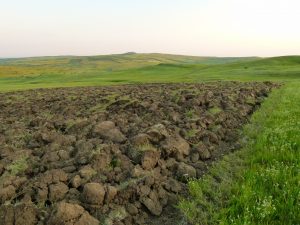
However, in this case the Natura 2000 network is not doing its job and these last few protected sites are being further damaged, forcing the viper ever closer to extinction. The cause, of course, is agricultural in practice but bureaucratic in origin. In a token gesture to increase agricultural productivity in the 1970’s, Ceaușescu declared large chunks of pastoral grasslands as officially being arable land. Much of the allocated land was soon ploughed and sown with crops, only to be abandoned a few years later due to the poor soil quality of the land and the lack of a well equipped work force to farm it productively. Over the coming decades it would revert naturally to secondary grasslands, again providing perfect habitats for the viper. Yet officially, the land remains defined as arable, while even the land that was never transformed from grasslands in the first place was put down on paper as arable by the local administration so as to cover their inability to follow orders. As such, even under the protection of Natura 2000, land owners can now legally change the land use type to arable as they like and still receive agro-environmental subsidies. As ploughing and re-sowing ensues, the viper’s habitats are being further fragmented and destroyed.
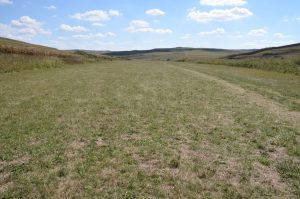
Where this is not the case and the land has remained pastoral, we are seeing an almost equally detrimental effect on the land from overgrazing with livestock. Again, this is a problem entrenched by subsidies. The money offered under the agro-environmental scheme for higher nature farmland, set up to protect biodiversity rich grasslands, pales in comparison to that which can be made from intensive livestock farming based also on free grazing or from arable farming, both of which entitle the landowner to subsidies as well as the increased profit that comes from more intensive farming. Even in Natura 2000 sites landowners are eligible to opt out of the higher nature farmland scheme and intensify their production.
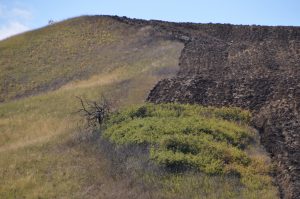
The decline of the meadow viper in these conditions is symptomatic of the wider loss in biodiversity that comes from overgrazing. In contrast to the majority of other European snakes, the meadow viper feeds heavily on insects and so requires highly biodiverse grasslands to live. It is unable to survive even temporarily in the adverse conditions of heavily grazed meadows.
It is a sad irony that it is now, as the Hungarian Meadow Viper is receiving its highest ever levels of scientific monitoring and conservation efforts at least at European level, that its extinction looms so threateningly in Romania. But the protection offered by Natura 2000 amounts to nothing if it is not enforced properly and if the definitions of what constitute healthy grasslands fall so close to the interests of intensive farming.
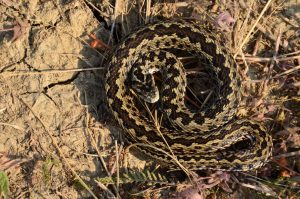
This can be changed, but only if challenged. We’ve seen it happen already in Pajiștile Lui Suciu, where Romania’s strongest meadow viper habitat was to be in part ploughed for maize and part used for cattle grazing (supported, ironically, by an EU grant). However, with strong opposition from the Romanian Herpetological Society, this was avoided and the grasslands kept in (relative) tact, affording the viper a stronghold- at least for that time.
To stop further declines in the species, we need a comprehensive plan. This must include the active administration of Natura 2000 sites, the allocation of higher subsidies to landowners actively involved in the protection of their land, and the challenging of the category of land types so as to protect grasslands under law.
If we can do this, the Hungarian Meadow Viper population has the chance to replenish and strengthen. If not, its future looks distinctly uncertain.
 History has been hard on the Hungarian Meadow Viper (Vipera ursinii rakosiensis). A subspecies of the grassland dwelling meadow viper (Vipera ursinii), it has been persecuted under the false fear that it may be dangerous, caught and sold as pets and poisoned by agricultural chemicals. Most devastatingly though, this once widespread subspecies has had its habitats increasingly destroyed as changes in land use have seen it’s native grasslands being ploughed for use as arable land, overgrazed and burned, forcing the viper into ever smaller pockets of protected land.
Now, it is one of the most threatened snake subspecies in Europe and, even with conservation policies being carried out to save it, the population is in decline. In Romania, there are four known habitat sites, three of which have been recently discovered or reconfirmed by scientists.. All the sites can be found in the steppe grasslands from hills of Cluj and Alba County and three are located within Natura 2000 protected areas while the fourth is in a proposed Natura 2000 site. The largest of these is Pajiștile lui Suciu, located in Alba County, and contains an estimated 300-400 Hungarian Meadow Vipers in an area of 200 ha (though the viper appears to live predominantly within just 30 ha of this space). The smallest is Pajiștile de la Rădești, also in Alba County, an area of 35 ha in size where just 2 vipers have been encountered.
History has been hard on the Hungarian Meadow Viper (Vipera ursinii rakosiensis). A subspecies of the grassland dwelling meadow viper (Vipera ursinii), it has been persecuted under the false fear that it may be dangerous, caught and sold as pets and poisoned by agricultural chemicals. Most devastatingly though, this once widespread subspecies has had its habitats increasingly destroyed as changes in land use have seen it’s native grasslands being ploughed for use as arable land, overgrazed and burned, forcing the viper into ever smaller pockets of protected land.
Now, it is one of the most threatened snake subspecies in Europe and, even with conservation policies being carried out to save it, the population is in decline. In Romania, there are four known habitat sites, three of which have been recently discovered or reconfirmed by scientists.. All the sites can be found in the steppe grasslands from hills of Cluj and Alba County and three are located within Natura 2000 protected areas while the fourth is in a proposed Natura 2000 site. The largest of these is Pajiștile lui Suciu, located in Alba County, and contains an estimated 300-400 Hungarian Meadow Vipers in an area of 200 ha (though the viper appears to live predominantly within just 30 ha of this space). The smallest is Pajiștile de la Rădești, also in Alba County, an area of 35 ha in size where just 2 vipers have been encountered.
 However, in this case the Natura 2000 network is not doing its job and these last few protected sites are being further damaged, forcing the viper ever closer to extinction. The cause, of course, is agricultural in practice but bureaucratic in origin. In a token gesture to increase agricultural productivity in the 1970’s, Ceaușescu declared large chunks of pastoral grasslands as officially being arable land. Much of the allocated land was soon ploughed and sown with crops, only to be abandoned a few years later due to the poor soil quality of the land and the lack of a well equipped work force to farm it productively. Over the coming decades it would revert naturally to secondary grasslands, again providing perfect habitats for the viper. Yet officially, the land remains defined as arable, while even the land that was never transformed from grasslands in the first place was put down on paper as arable by the local administration so as to cover their inability to follow orders. As such, even under the protection of Natura 2000, land owners can now legally change the land use type to arable as they like and still receive agro-environmental subsidies. As ploughing and re-sowing ensues, the viper’s habitats are being further fragmented and destroyed.
However, in this case the Natura 2000 network is not doing its job and these last few protected sites are being further damaged, forcing the viper ever closer to extinction. The cause, of course, is agricultural in practice but bureaucratic in origin. In a token gesture to increase agricultural productivity in the 1970’s, Ceaușescu declared large chunks of pastoral grasslands as officially being arable land. Much of the allocated land was soon ploughed and sown with crops, only to be abandoned a few years later due to the poor soil quality of the land and the lack of a well equipped work force to farm it productively. Over the coming decades it would revert naturally to secondary grasslands, again providing perfect habitats for the viper. Yet officially, the land remains defined as arable, while even the land that was never transformed from grasslands in the first place was put down on paper as arable by the local administration so as to cover their inability to follow orders. As such, even under the protection of Natura 2000, land owners can now legally change the land use type to arable as they like and still receive agro-environmental subsidies. As ploughing and re-sowing ensues, the viper’s habitats are being further fragmented and destroyed.
 Where this is not the case and the land has remained pastoral, we are seeing an almost equally detrimental effect on the land from overgrazing with livestock. Again, this is a problem entrenched by subsidies. The money offered under the agro-environmental scheme for higher nature farmland, set up to protect biodiversity rich grasslands, pales in comparison to that which can be made from intensive livestock farming based also on free grazing or from arable farming, both of which entitle the landowner to subsidies as well as the increased profit that comes from more intensive farming. Even in Natura 2000 sites landowners are eligible to opt out of the higher nature farmland scheme and intensify their production.
Where this is not the case and the land has remained pastoral, we are seeing an almost equally detrimental effect on the land from overgrazing with livestock. Again, this is a problem entrenched by subsidies. The money offered under the agro-environmental scheme for higher nature farmland, set up to protect biodiversity rich grasslands, pales in comparison to that which can be made from intensive livestock farming based also on free grazing or from arable farming, both of which entitle the landowner to subsidies as well as the increased profit that comes from more intensive farming. Even in Natura 2000 sites landowners are eligible to opt out of the higher nature farmland scheme and intensify their production.
 The decline of the meadow viper in these conditions is symptomatic of the wider loss in biodiversity that comes from overgrazing. In contrast to the majority of other European snakes, the meadow viper feeds heavily on insects and so requires highly biodiverse grasslands to live. It is unable to survive even temporarily in the adverse conditions of heavily grazed meadows.
It is a sad irony that it is now, as the Hungarian Meadow Viper is receiving its highest ever levels of scientific monitoring and conservation efforts at least at European level, that its extinction looms so threateningly in Romania. But the protection offered by Natura 2000 amounts to nothing if it is not enforced properly and if the definitions of what constitute healthy grasslands fall so close to the interests of intensive farming.
The decline of the meadow viper in these conditions is symptomatic of the wider loss in biodiversity that comes from overgrazing. In contrast to the majority of other European snakes, the meadow viper feeds heavily on insects and so requires highly biodiverse grasslands to live. It is unable to survive even temporarily in the adverse conditions of heavily grazed meadows.
It is a sad irony that it is now, as the Hungarian Meadow Viper is receiving its highest ever levels of scientific monitoring and conservation efforts at least at European level, that its extinction looms so threateningly in Romania. But the protection offered by Natura 2000 amounts to nothing if it is not enforced properly and if the definitions of what constitute healthy grasslands fall so close to the interests of intensive farming.
 This can be changed, but only if challenged. We’ve seen it happen already in Pajiștile Lui Suciu, where Romania’s strongest meadow viper habitat was to be in part ploughed for maize and part used for cattle grazing (supported, ironically, by an EU grant). However, with strong opposition from the Romanian Herpetological Society, this was avoided and the grasslands kept in (relative) tact, affording the viper a stronghold- at least for that time.
To stop further declines in the species, we need a comprehensive plan. This must include the active administration of Natura 2000 sites, the allocation of higher subsidies to landowners actively involved in the protection of their land, and the challenging of the category of land types so as to protect grasslands under law.
If we can do this, the Hungarian Meadow Viper population has the chance to replenish and strengthen. If not, its future looks distinctly uncertain.
This can be changed, but only if challenged. We’ve seen it happen already in Pajiștile Lui Suciu, where Romania’s strongest meadow viper habitat was to be in part ploughed for maize and part used for cattle grazing (supported, ironically, by an EU grant). However, with strong opposition from the Romanian Herpetological Society, this was avoided and the grasslands kept in (relative) tact, affording the viper a stronghold- at least for that time.
To stop further declines in the species, we need a comprehensive plan. This must include the active administration of Natura 2000 sites, the allocation of higher subsidies to landowners actively involved in the protection of their land, and the challenging of the category of land types so as to protect grasslands under law.
If we can do this, the Hungarian Meadow Viper population has the chance to replenish and strengthen. If not, its future looks distinctly uncertain.

